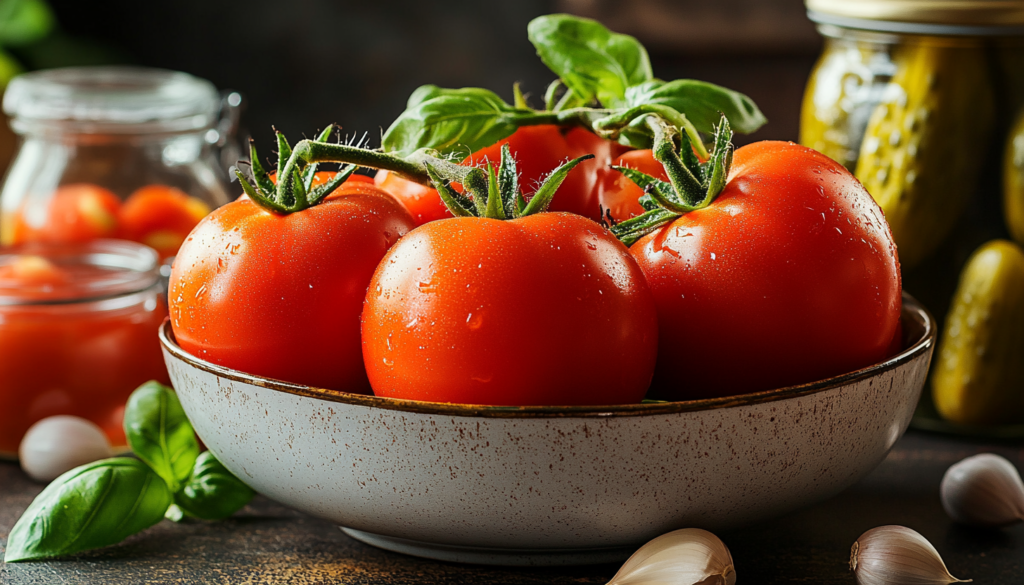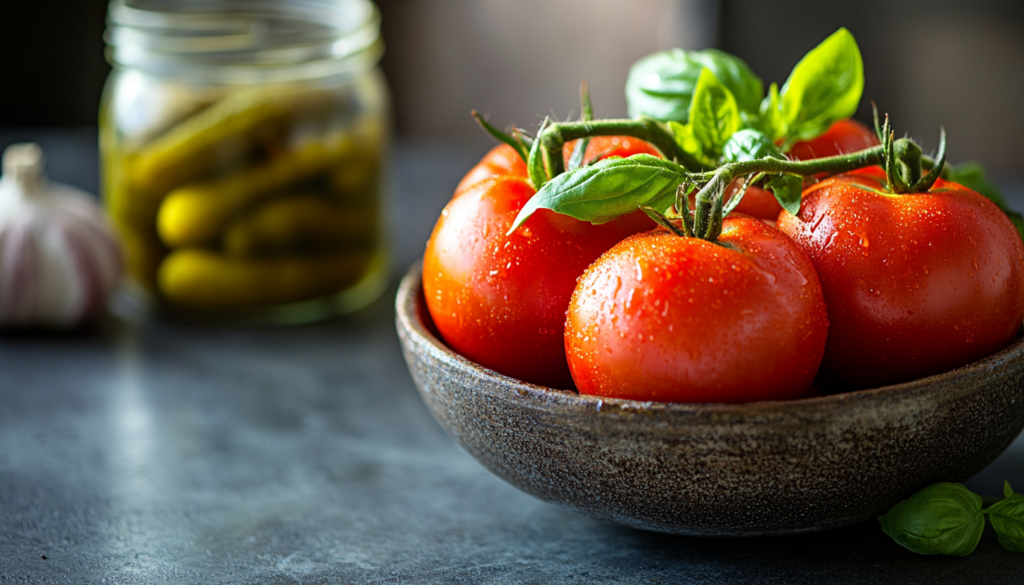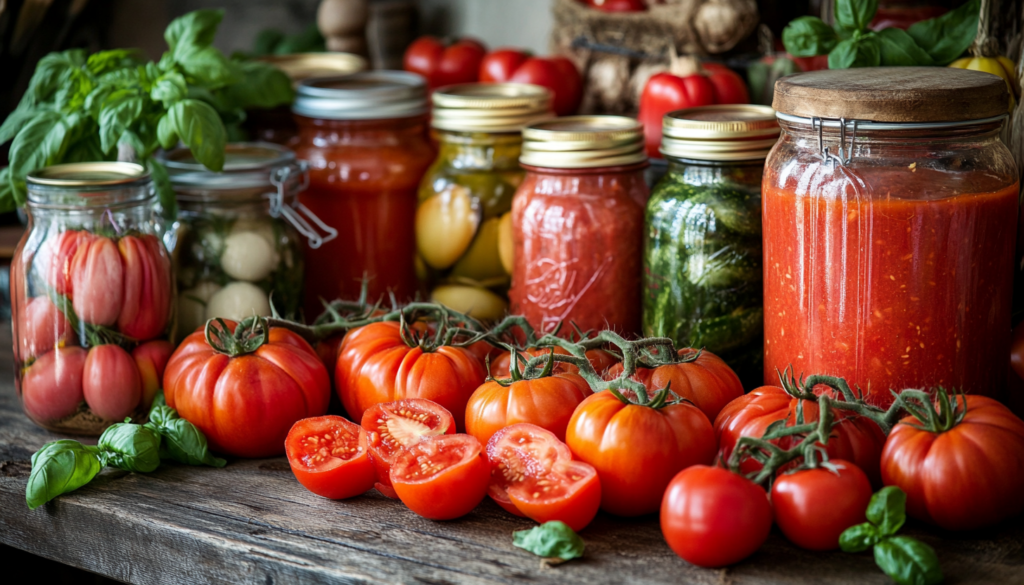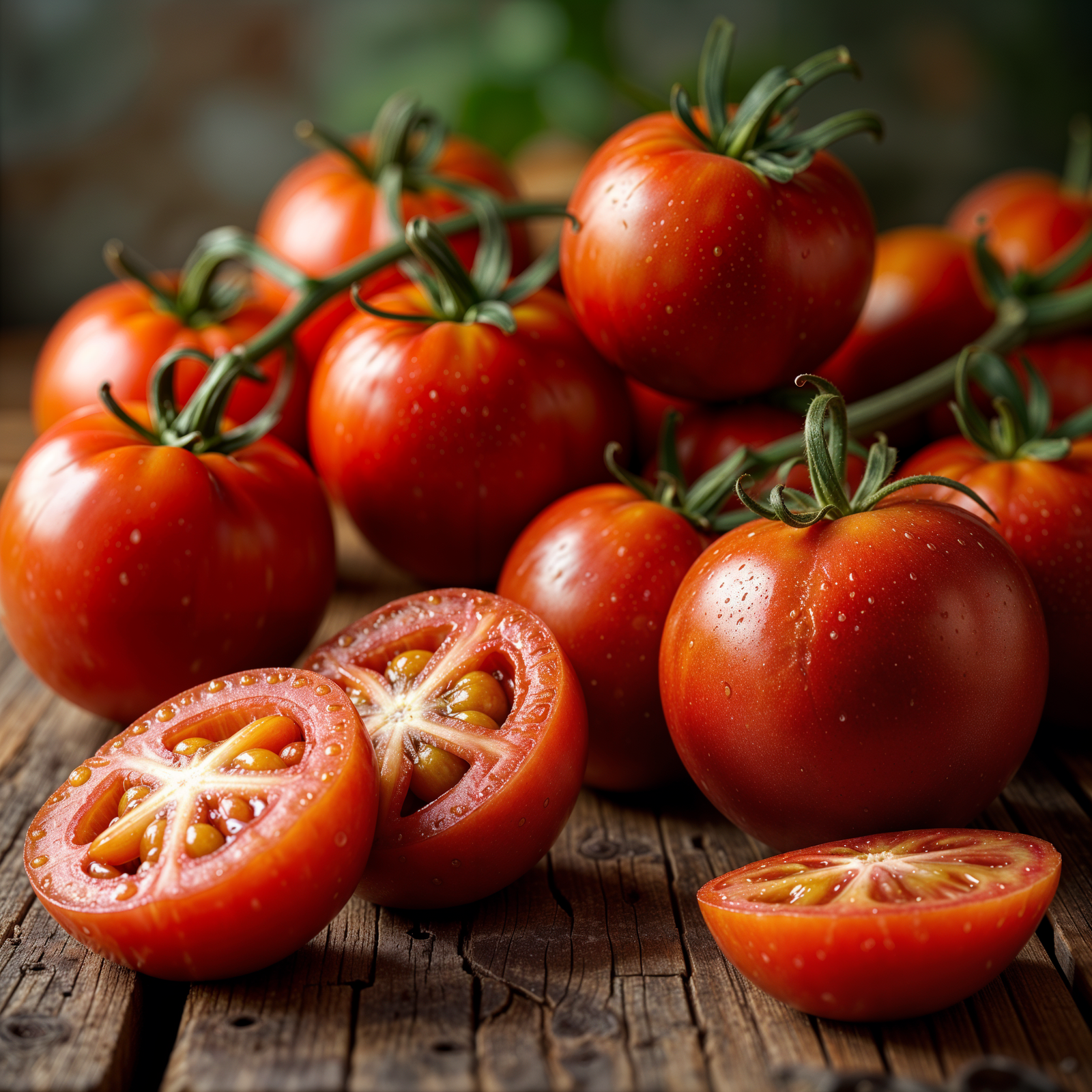I love gardening and tomatoes, especially the Roma variety. These tomatoes are great for making sauces and canning. They are long and meaty, perfect for preserving summer’s flavors. The Roma tomato is a top choice for canning.
More tomatoes are canned in the U.S. than any other product, and Roma tomatoes are best for it. They have less moisture, dense flesh, and few seeds. This makes them ideal for sauces. Roma tomatoes also grow a lot, resist diseases, and have skin that’s easy to remove. These traits make them great for canning.

Key Takeaways
- Roma tomatoes are a determinate variety, staying compact and bearing fruit over a 3-4 week period, ideal for canning large batches.
- Roma tomatoes have a low moisture content, dense flesh, and small seed cavities, making them perfect for sauces and pastes.
- Roma tomatoes are disease-resistant and have a tough, easily removable skin, further enhancing their suitability for canning and preserving.
- Specific Roma tomato varieties like San Marzano and Amish Paste offer unique characteristics for various canning and cooking needs.
- Roasting Roma tomatoes can enhance their flavor and reduce the need for additional liquid in sauces, creating a rich, caramelized sauce.
What is a Roma Tomato?
Roma tomatoes, also known as plum or paste tomatoes, are a top choice for sauces and canning. They are oblong, egg-shaped paste tomatoes with a dense, meaty texture. This makes them great for turning into thick, tasty sauces and preserves.
Characteristics of Roma Tomatoes
Roma tomatoes weigh about 60 grams (2.1 ounces) and take around 75 days to mature. They can grow up to 1 meter (3.3 feet) tall. Roma tomatoes stand out because they have few seeds and strong walls. These walls keep their shape and texture well when cooked and canned.
Why Roma Tomatoes are Ideal for Sauces and Canning
Roma tomatoes are perfect for sauces and canning because they have low moisture and a dense flesh. This means they cook down quickly into a thick, tasty sauce. Their strong walls also keep their shape during canning. Plus, they have small seed cavities, which means less waste and more usable flesh for making sauces and canning.
“Roma tomatoes are the ideal variety for making sauces and canning due to their unique characteristics. Their low moisture content means they require less cooking time to reduce and thicken into a rich, flavorful sauce.”
Popular Roma Tomato Varieties
Two Roma tomato varieties are known for their great taste and versatility: San Marzano and Amish Paste. These tomatoes are perfect for many dishes because of their unique qualities.
San Marzano
The San Marzano tomato is a top choice for making real Italian sauces. It comes from the Campania region of Italy. These tomatoes are sweet, have a low acid taste, and are full of flavor.
They are great for making pizza, pasta, and canned tomato products. Their quality really stands out in these dishes.
Amish Paste
The Amish Paste is another favorite Roma-style tomato. It’s bigger than regular Romas and has a meaty, dry inside. This makes it ideal for thick, tasty sauces.
Amish Paste tomatoes are loved for their big yields and strong flavor. They are a top pick for gardeners and those who like to can food.
For making true Italian sauces or preserving your garden’s produce, these Roma tomato types are key. They are a must-have for any cook or preserver at home.
Growing Roma Tomatoes
Climate and Growing Conditions
Roma tomatoes love warm, sunny spots and soil that drains well. They do best in a Mediterranean climate with hot, dry summers. But, they can grow in other places too, with the right care. These tomatoes handle the heat well and keep producing fruit in the summer.
But, they might get diseases like blossom-end rot in hot, humid weather.
Planting and Care
Plant Roma tomatoes in full sun and soil that drains well after the last frost. They grow as determinate or bush-type plants, meaning they produce fruit all at once. They need regular water, especially when they’re making fruit. They might need staking or caging to hold up the heavy fruit.
Pruning isn’t needed for Roma plants. They’re made to produce a certain amount of fruit without extra help.
- Roma tomatoes are firmer because of their thick skin and fewer seeds than other tomatoes.
- Determinate Roma tomatoes should be spaced 12 to 24 inches apart. Indeterminate types need 2 to 3 feet between plants, with rows 4 to 6 feet apart.
- Tomatoes, including Roma, need at least six to eight hours of direct sunlight to grow well.
- For healthy growth, Roma tomatoes need soil that drains well, is loamy, and a bit acidic, with a pH between 6.2 and 6.8.
- They should get at least 1 to 1.5 inches of water per week to keep the soil moist.
With the right climate, soil, and care, Roma tomatoes can be a great addition to any garden or farm. They’re perfect for sauces, canning, and other recipes because of their unique traits.
Roma Tomato Harvesting and Storage
Harvesting and storing Roma tomatoes is all about timing and technique. These tomatoes are ready when they’re fully grown and have turned deep red. You can pick them one by one as they ripen or wait for the whole plant to be ready.
After picking, it’s important to store them right to keep their quality and taste. Store them at room temperature in a cool, dry spot. This keeps them fresh for weeks, perfect for canning or processing. Don’t put them in the fridge, as the cold can change their texture and taste.
| Harvesting Roma Tomatoes | Storing Roma Tomatoes |
|---|---|
| Harvest when tomatoes are fully ripe, with a deep red color Can pick individually or harvest entire plant at once Carefully remove tomatoes from the vine, leaving a small stem attached | Store at room temperature in a cool, dry place Avoid refrigerating, as cold temperatures can affect texture and flavor Properly stored Roma tomatoes can last up to several weeks |
Follow these easy tips for harvesting and storing your Roma tomatoes. You’ll enjoy their tasty flavor in sauces, canned goods, and more.
Canning Roma Tomatoes
Canning Roma tomatoes is a great way to keep their delicious taste for later. You can use them to make tomato sauce, salsa, or pasta sauces. Let’s look at how to prepare and can these tomatoes.
Preparing Roma Tomatoes for Canning
Start by washing the tomatoes and taking out any stems or cores. To peel them easily, put the tomatoes in boiling water for 5 minutes. Then, cool them down in an ice bath and peel by hand.
After peeling, you can core and cut the tomatoes into pieces like halves or quarters. This depends on what you plan to use them for.
Canning Methods and Recipes
You can can Roma tomatoes using water bath or pressure canning. Water bath is good for whole or diced tomatoes. Pressure canning is better for sauces and purees to keep them safe and acidic.
Here are some tasty canning recipes using Roma tomatoes:
- Classic Tomato Sauce: This recipe mixes canned Roma tomatoes, garlic, onions, and herbs. It’s great for pasta.
- Chunky Tomato Salsa: It combines diced Roma tomatoes, onions, jalapeños, cilantro, and lime juice. This makes a fresh and spicy salsa.
- Robust Pasta Sauce: This sauce blends canned Roma tomatoes with sautéed veggies, Italian seasoning, and a bit of cream. It’s perfect for pasta.
Choosing the right canning method or recipe is important. But the main thing is to follow food safety rules and can properly. With care, you can enjoy summer flavors all year.
Making Sauces with Roma Tomatoes
Roma tomatoes are perfect for making thick, flavorful tomato sauces. They have low moisture and dense flesh. This makes them cook down into a rich sauce without needing to simmer for a long time. Classic Italian tomato sauce recipes like marinara or Bolognese really bring out the sweet and bold taste of Roma tomatoes. Plus, their small seed cavities mean less waste and more usable tomato flesh for your sauces.
Tomato Sauce Recipes
One of our top roma tomato sauce recipes is a simple, homemade version. It’s quick to make, ready in just 25 minutes. Prep time is 5 minutes, and cooking takes 20 minutes.
| Ingredient | Quantity |
|---|---|
| Roma tomatoes, cut into 1-2 inch pieces | 5 pounds |
| Minced garlic | 1 clove |
| Olive oil | 1/4 cup |
Roma tomatoes don’t need blanching or peeling for this sauce, saving time. The author likes using an immersion blender for a smooth texture. This italian tomato sauce keeps well in the fridge for a few days or can be frozen, making it a great addition to your meals.
Salsa and Pasta Sauce Recipes
Roma tomatoes are also great for making roma tomato salsa recipes and roma tomato pasta sauce recipes. Their firm texture and low moisture are perfect for salsas, keeping their shape and not getting watery. For pasta sauces, their concentrated flavor and thick consistency make a hearty, authentic italian tomato sauce that sticks well to pasta.

“The author emphasizes the simplicity and flavor of the Roma tomatoes in the sauce, making it a go-to choice for tomato sauce recipes.”
Nutritional Benefits of Roma Tomatoes
Roma tomatoes are known for their amazing nutritional value. They are a top choice for anyone looking to eat healthy. These tomatoes are full of vitamins, minerals, and antioxidants that are great for your health.
A single medium-sized Roma tomato has only 11 calories. It also has 1.6 grams of sugar, 2.4 grams of carbs, 0.7 grams of fiber, 0.6 grams of protein, and almost no fat. They are a low-calorie food that is full of important nutrients like vitamin C, vitamin K, potassium, and lycopene.
Lycopene, the red color of Roma tomatoes, fights cancer, especially prostate cancer in men. It can also help men have healthier sperm. This makes it a key nutrient for men’s health.
Roma tomatoes also have chlorogenic acid, vitamins A and C, and more. These nutrients help keep your skin, hair, and nails healthy. They are also good for people with diabetes because they help control blood sugar.
You can eat Roma tomatoes fresh, in sauces, or canned. They are a great addition to any diet. Adding them to your meals is a tasty way to get the health benefits of roma tomato nutrition.
| Nutrient | Amount per Medium Roma Tomato |
|---|---|
| Calories | 11 |
| Carbohydrates | 2.4 g |
| Fiber | 0.7 g |
| Protein | 0.6 g |
| Vitamin C | 17 mg |
| Lycopene | 3.2 mg |
Roma tomatoes are a great choice for anyone who cares about their health. They are full of antioxidants that help your heart and keep your blood sugar stable. The health benefits of roma tomatoes are truly impressive.
Troubleshooting Common Roma Tomato Issues
As a Roma tomato grower, I’ve faced a few challenges. But with some troubleshooting, I’ve overcome them and enjoyed great harvests. Let’s look at common Roma tomato problems and how to fix them.
Blossom-End Rot
Blossom-end rot is a big problem for Roma tomato growers. It happens when there’s not enough calcium, often because of uneven soil moisture or the wrong pH levels. To fight this, I keep the soil moist and check the pH. If needed, I adjust it to 6.5. Giving plants balanced fertilizer and calcium supplements also helps.
Fungal Diseases
Roma tomatoes can get fungal diseases like early blight and Septoria leaf spot. I prevent this by cleaning up affected leaves and debris and rotating crops. Choosing tomatoes that resist disease also helps a lot.
Cracking
Cracking is another issue with Roma tomatoes, caused by sudden changes in moisture. To stop this, I water my plants regularly and mulch around them. This keeps the soil moisture steady.
Roma tomatoes are tough and fight off many diseases. But, a bit of troubleshooting and care can make a big difference. By tackling issues like blossom-end rot, fungal diseases, and cracking, I’ve had great Roma tomato harvests every year.
Companion Planting with Roma Tomatoes
Companion planting can greatly improve your Roma tomatoes. Plants like basil, marigolds, and nasturtiums keep pests away. Others, such as borage and bee balm, attract insects that eat tomato pests. By choosing the right plants to grow with your tomatoes, you can make your garden more productive and healthy.
Basil is a top choice for Roma tomatoes. It tastes great with tomatoes and keeps thrips and tomato hornworms away. Marigolds also help by releasing a chemical that keeps whiteflies off. Nasturtiums draw aphids and other pests away from your tomatoes.
Consider adding these plants to your Roma tomato garden:
- Garlic repels moths, cabbage loopers, and root maggots
- Onions keep pests away, except for thrips
- Lavender repels mosquitoes and aphids and attracts pollinators
- Chives protect against aphids and spider mites
- Asparagus acts as a fungicide and keeps asparagus beetles away
- Celery deters bugs that harm tomatoes
- Parsley attracts hoverflies that eat aphids
- Peppers are good companions for tomatoes, helping with salsa and disease prevention
Companion planting with Roma tomatoes is backed by science and tradition. It makes your garden healthier and more productive. Try it out and see your Roma tomatoes thrive!
| Companion Plant | Benefits for Roma Tomatoes |
|---|---|
| Basil | Repels thrips and tomato hornworms, enhances flavor |
| Marigolds | Deter whiteflies and other pests with their limonene |
| Garlic | Repels moths, cabbage loopers, and root maggots |
| Onions | Deter pests with their strong odor, except for thrips |
| Lavender | Repels mosquitoes and aphids, attracts beneficial pollinators |
| Chives | Protect against aphids and spider mites with their natural oils |
| Asparagus | Act as a natural fungicide and deter asparagus beetles |
| Celery | Deter bugs that harm tomatoes with its strong scent |
| Parsley | Attract hoverflies that feed on aphids |
| Peppers | Good companions for tomatoes, aid in salsa-making and disease resistance |
Preserving Roma Tomatoes Beyond Canning
While canning is a common way to keep Roma tomatoes fresh, there are other methods too. You can dry them into sun-dried tomato delights or freeze them for later. These methods help keep their tasty flavors.
Drying Roma Tomatoes
Drying Roma tomatoes is great for intensifying their flavors. Their low moisture makes them perfect for drying. This turns them into sun-dried tomatoes that are great for many dishes.
You can use them in sauces, salads, pasta, and on pizza. It’s a versatile ingredient.
Freezing Roma Tomatoes
Freezing Roma tomatoes is another option. You can freeze them whole, diced, or pureed. This is useful for sauces, soups, and more.
Freezing keeps their texture and taste for months. Whole tomatoes are versatile for many dishes. Chopped or pureed tomatoes are handy for recipes that need diced or crushed tomatoes.
Choosing to dry or freeze your Roma tomatoes lets you enjoy them longer than the growing season.

Roma Tomato Festivals and Events
As the weather gets warmer, tomato fans can’t wait for the Roma tomato festival season. These festivals celebrate the Roma tomato, known for its great taste in sauces and canning. They happen all over the United States and other countries.
The Tomatina in Buñol, Spain, is a top Roma tomato festival. It’s a huge food fight where 40,000 to 50,000 people throw over 100 metric tons of tomatoes at each other. Since 2013, only 20,000 people can attend because of ticket limits.
“The festival cleaning process involves the use of fire trucks and water sprayed from a Roman aqueduct, showcasing the sheer scale of this tomato-centric celebration.”
In Moorpark, California, the “Pick Your Own Roma Tomatoes” event has been a favorite for over 40 years. Visitors can pick their own tomatoes for 40 cents a pound or choose pre-picked ones for 70 cents a pound. This event is set for August 31 and September 1, 2024, and also offers bell peppers and basil.
Love for roma tomato festivals, tomato festivals, and tomato events is strong across the country. The Tomato Art Fest in Nashville, Tennessee, highlights tomatoes in art and food. The “Tomatomania!” festival in Southern California shows off the variety and taste of tomatoes.
As tomato season peaks, these festivals are a great chance for cooks of all levels to dive into the world of tomatoes. Whether it’s a big food fight, picking your own tomatoes, or celebrating tomatoes, these events are unforgettable for tomato lovers of all ages.
Roma Tomato Gardening Resources
Growing Roma tomatoes is a rewarding hobby. You can make delicious sauces and enjoy fresh, tasty tomatoes. There are many resources to help you grow these plants. You can find online guides and local services that offer support.
For roma tomato growing guides, I look at gardening websites and blogs. They have detailed instructions on how to plant, care for, and harvest Roma tomatoes. These guides help me understand what Roma tomatoes need, making my gardening better.
Local cooperative extension services are also great for tomato gardening resources. They have experts who give advice on tomato cultivation tips for your area. They suggest the best Roma tomato varieties and help with growing challenges.
Online forums and social media groups are great for connecting with other gardeners. We share tips, solve problems, and celebrate our successes. This has made me a better gardener and brought us together in our love for Roma tomatoes.
With all these resources, growing Roma tomatoes is fun and rewarding. It doesn’t matter if you’re new to gardening or have been doing it for years. I recommend checking out the guides, services, and communities out there to help you grow great Roma tomatoes.
Roma Tomatoes in Italian Cuisine
The Roma tomato is a star in traditional Italian cooking. These tomatoes are long and shaped like pears. They are loved for their thick flesh and strong taste. This makes them key in many famous dishes.
Roma tomatoes are essential in making marinara and Bolognese sauces for spaghetti. They also add flavor to Neapolitan pizza and Sicily’s caponata. Their shape holds up well when cooked, making them great for canning. This lets people enjoy Italian summer flavors all year.
Roma tomatoes are not just for sauces and dips. They’re also great in salads and snacks. The Caprese salad with mozzarella, basil, and Roma tomatoes is a summer favorite. And who can forget the tasty pomodori secchi, or sun-dried Roma tomatoes, in olive oil?
Italy has many tomato types, each with its own use. But Roma tomatoes are a true symbol of Italian food. They have a firm texture and just the right acidity. This makes them perfect for the bold flavors of Italian dishes.
| Italian Tomato Variety | Characteristics | Culinary Uses |
|---|---|---|
| Roma Tomato | Elongated pear shape, dense flesh, concentrated flavor | Canning, tomato sauce, pizza, salads |
| San Marzano Tomato | Thin, pointed shape, bittersweet taste | Neapolitan pizza, tomato sauce |
| Cuore di Bue Tomato | Beefsteak shape, juicy and dense flesh | Sauces, pesto, jams |
| Pomodori Pelati | Whole peeled tomatoes, chunky texture | Tomato sauce, soups |
| Pomodori Secchi | Sun-dried tomatoes preserved in olive oil | Salads, pasta, pesto |
Tomato products like Concentrato di Pomodoro, Passata di Pomodoro, and Polpa di Pomodoro are key in Italian cooking. The Roma tomato is at the heart of these products. It’s a symbol of Italian cuisine that has lasted through time.
Conclusion
Roma tomatoes are amazing in the garden and the kitchen. They have low moisture, dense flesh, and few seeds. This makes them perfect for canning, saucing, and preserving. They bring the true taste of Italian cuisine to your table.
Whether you grow your own roma tomatoes or buy them, they’re a great choice. They make your tomato sauce and tomato canning taste amazing. Your friends and family will love what you make.
Roma tomatoes are great for gardeners and cooks. They grow well, resist diseases, and taste great in sauces and preserves. They’re a key ingredient for making real Italian cuisine. With good care and creativity, they can be a big part of your cooking.
As we wrap up our look at roma tomatoes, I hope you’re excited to try them. You can plant them in your garden or use them in your cooking. These tomatoes are versatile and delicious. They will be a favorite in your kitchen, offering many tasty dishes.
FAQ
What are the characteristics of Roma tomatoes?
Roma tomatoes are known for their long, oval shape and dense flesh. They have fewer seeds inside. This makes them great for sauces and canning because they don’t lose much water when cooked.
Why are Roma tomatoes ideal for sauces and canning?
These tomatoes are perfect for sauces and canning because they cook down quickly and have a thick, flavorful sauce. They also keep well during the canning process.
What are some popular Roma tomato varieties?
Popular Roma varieties include San Marzano and Amish Paste. San Marzano tomatoes are sweet and have a thick flesh, ideal for Italian sauces. Amish Paste tomatoes are bigger and also great for sauces because they’re low in moisture.
What are the ideal growing conditions for Roma tomatoes?
Roma tomatoes love warm, sunny spots and well-drained soil. They do well in a Mediterranean climate but can grow in other places too. They’re also more resistant to heat than some other tomatoes.
How should Roma tomatoes be harvested and stored?
Harvest Roma tomatoes when they’re fully red and large. You can pick them all at once. They keep well at room temperature for weeks, making them perfect for canning or freezing.
What are the steps for canning Roma tomatoes?
Start by washing and removing stems and cores. Then, briefly boil them to make the skin easy to remove. After peeling and coring, you can can them using water bath or pressure canning.
How can Roma tomatoes be used to make sauces?
Roma tomatoes are great for sauces because they cook down to a rich, thick sauce. They’re often used in Italian sauces, salsa, and pasta dishes.
What are the nutritional benefits of Roma tomatoes?
Roma tomatoes are full of vitamins C and K, potassium, and the antioxidant lycopene. Their dense flesh means they have more of these nutrients than some other tomatoes.
What are some common issues that can affect Roma tomatoes?
Roma tomatoes might get blossom-end rot, fungal diseases, or crack. End rot happens when the soil lacks calcium. Diseases can be fought with good sanitation and resistant plants. Cracking can be prevented with steady watering and mulching.
How can companion planting help with growing Roma tomatoes?
Planting certain friends like basil and marigolds with Roma tomatoes can keep pests away. Others, like borage, attract good bugs. Growing tomatoes with peppers or eggplants also uses garden space well.
What are some other ways to preserve Roma tomatoes besides canning?
You can dry or freeze Roma tomatoes too. Drying them makes sun-dried tomatoes that last a long time. Freezing them whole or as puree is also an option for sauces and soups.
Where can I find resources for growing and using Roma tomatoes?
For growing and using Roma tomatoes, check out gardening guides, online resources, and local gardening groups. These can offer tips on planting, care, and preserving these tomatoes.

